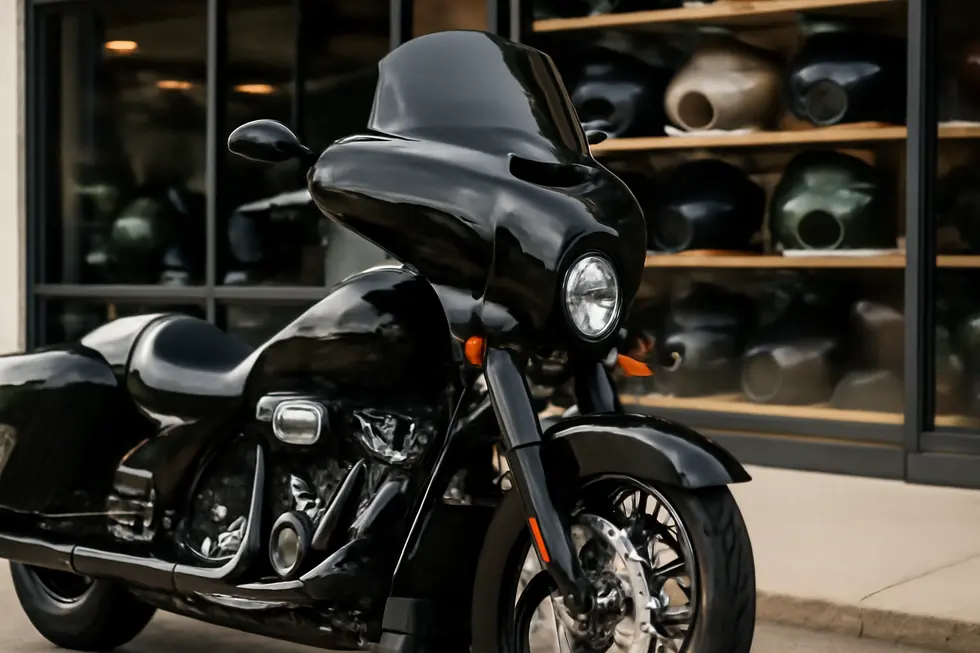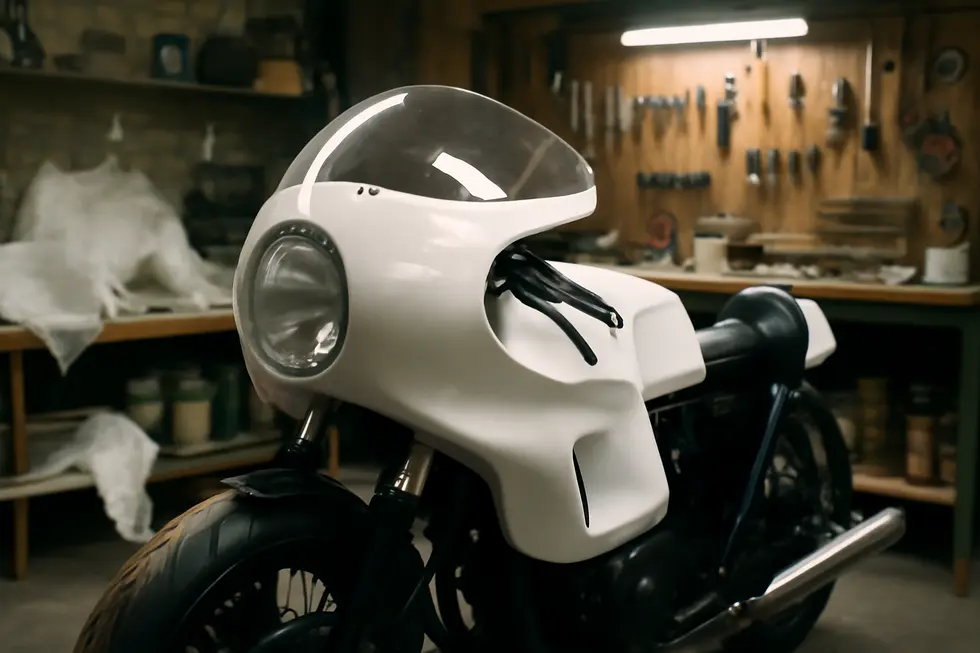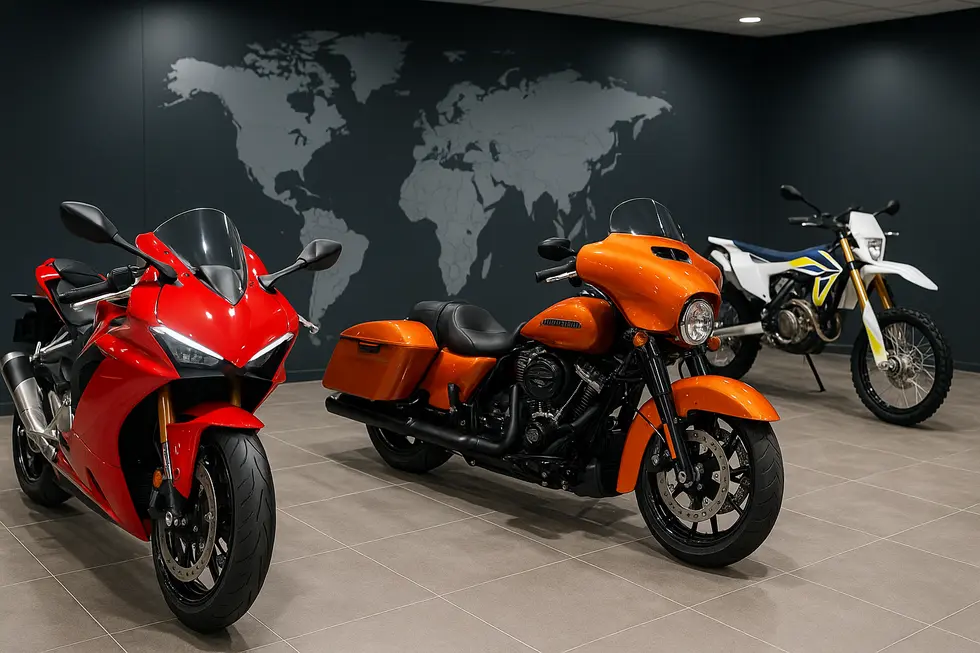Mastering Motorcycle Fairing Paint Designs: Techniques, Styles, and Longevity
October 11, 2025 | by summitfairings
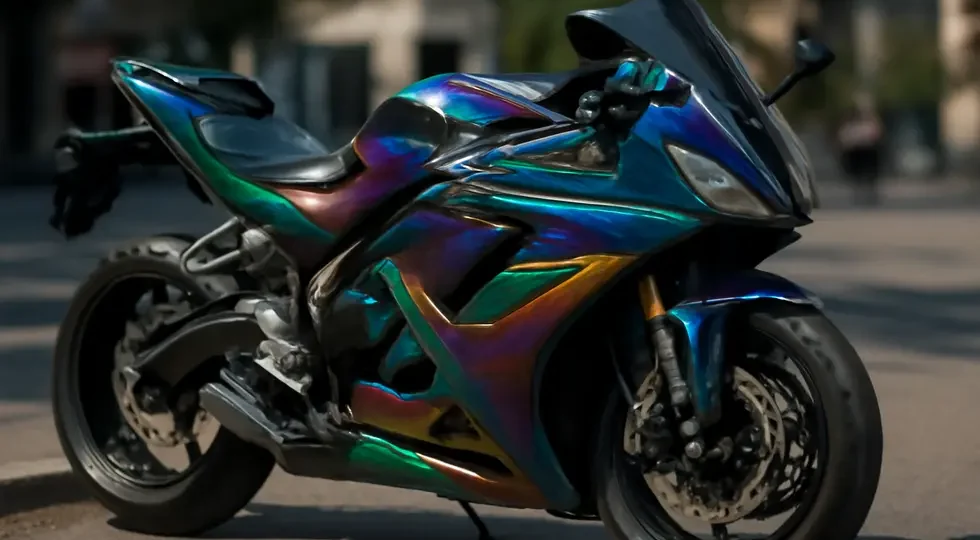
Introduction
Motorcycle fairing paint designs play a pivotal role in defining the visual identity and market appeal of motorcycles. For business owners in the motorcycle aftermarket or customization sector, understanding the technological processes, aesthetic options, and maintenance demands of fairing paint can unlock new opportunities to meet diverse customer preferences and raise quality standards. This guide explores advanced painting techniques ensuring exceptional finish quality, surveys the spectrum of design options that captivate riders seeking unique styles, and discusses maintenance strategies that safeguard the longevity and vibrancy of these finishes. With a detailed foundation in each key aspect, business owners can enhance their product offerings, streamline service delivery, and ultimately boost customer satisfaction.
Tables of Contents
Chapter 1: Technological Techniques in Motorcycle Fairing Paint Designs
- Mastering Advanced Painting Techniques for Durable and Striking Motorcycle Fairings
- Harnessing Computer-Aided Design for Precision and Personalization in Fairing Paintwork
- Integrating UV-Resistant Coatings for Long-Lasting Motorcycle Fairing Finishes
- Ensuring Longevity and Brilliance: Maintenance and Protective Strategies for Motorcycle Fairing Paints
- Innovative Repair and Restoration Methods to Revive Motorcycle Fairing Finishes
Chapter 2: Exploring Aesthetic and Customization Options for Motorcycle Fairing Paint Designs
- Diverse Finish and Design Choices Elevating Motorcycle Fairing Paint Customization
- How Fairing Materials and Construction Quality Shape Paint Design Possibilities
- Exploring the Boundless Creativity of Custom Motorcycle Fairing Paint Designs
- Mastering Finishing Techniques to Elevate Motorcycle Fairing Paint Designs
- Integrating Durability and Personalized Style in Motorcycle Fairing Paint Designs
Chapter 3: Ensuring Longevity: Maintenance and Durability in Motorcycle Fairing Paint Designs
- Essential Care for Motorcycle Fairings: Techniques for Cleaning, Protection, and Timely Inspections
- Environmental Challenges and Protective Strategies for Lasting Motorcycle Fairing Paints
- Effective Repair and Restoration Techniques to Preserve Motorcycle Fairing Paints
- Innovations in Application and Protective Coatings Enhancing Fairing Longevity
- Economic and Social Benefits of Durable Paint: Enhancing Value and Rider Experience
Chapter 1: Technological Techniques in Motorcycle Fairing Paint Designs
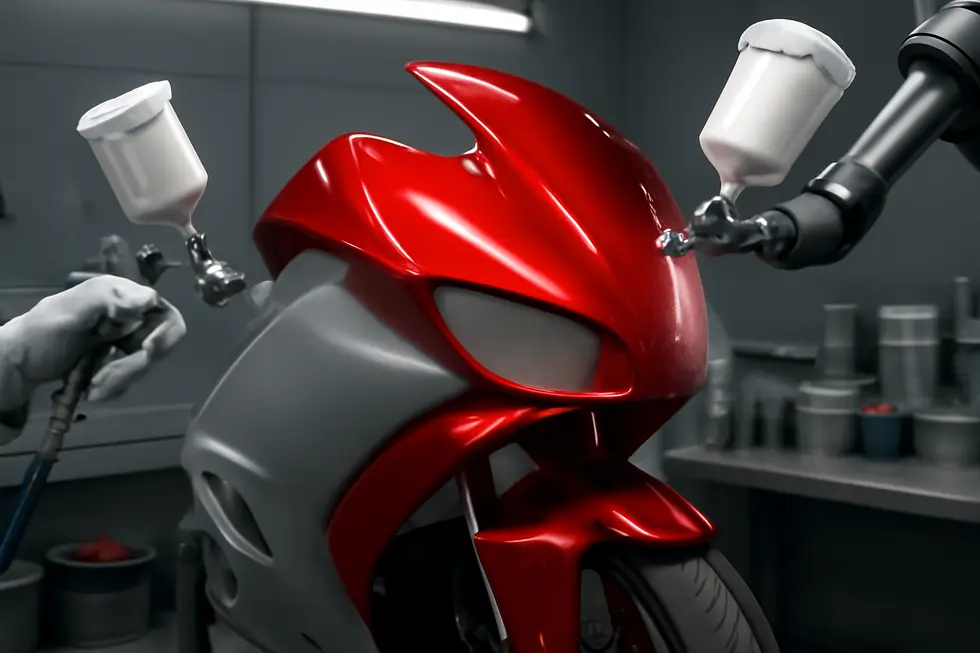
1. Mastering Advanced Painting Techniques for Durable and Striking Motorcycle Fairings
Achieving a flawless motorcycle fairing paint design requires mastering advanced painting techniques that blend chemistry, precision, and artistry. The process begins with meticulous surface preparation—wetsanding and polishing the fairing using fine abrasives and soft polishing pads ensures a smooth foundation free of imperfections. Controlled buffing speeds and hand finishing maximize the gloss and create an even surface ready for paint adhesion.
To prevent corrosion and guarantee longevity, epoxy primers are applied especially on metal components. These primers create a resilient base, reducing risks of peeling and cracking while improving topcoat durability. The paint itself can be cured using cutting-edge UV light solidification, which dramatically intensifies color saturation and resistance to fading by rapidly hardening the paint layers.
For intricate customization, airbrushing combined with stencils allows artists to produce detailed gradients and sharp designs with remarkable precision. Additionally, specialized finishes such as candy paint or simulated carbon fiber are deployed depending on the material and stylistic goals, enhancing both aesthetics and texture.
The entire multilayer process culminates in protective clear coats deeply shielding the design from UV damage and oxidation. This synergy of surface prep, primer technology, innovative curing, and artistic techniques results in vibrant, long-lasting paint jobs that stand up to environmental challenges while turning heads on the road. For those interested in exploring these techniques further, specialized resources on motorcycle fairing options can provide valuable insights.
2. Harnessing Computer-Aided Design for Precision and Personalization in Fairing Paintwork
Computer-Aided Design (CAD) has become a transformative tool in motorcycle fairing paint designs, enabling unmatched precision and creative freedom. By crafting detailed 3D models in a virtual space, designers can visualize complex paint patterns and color combinations before a single coat is applied. This reduces costly trial-and-error, streamlines prototyping, and ensures accuracy in replicating intricate designs. The ability to simulate finishes—such as metallic flakes or chameleon effects—within the CAD environment allows refinements that elevate visual impact. Moreover, CAD facilitates seamless collaboration by providing clear, standardized digital blueprints that painting technicians can follow to reproduce designs consistently, even across multiple units.
Beyond efficiency, CAD empowers customization, allowing riders to personalize their fairings with unique graphics, logos, or color schemes. Integrating client input digitally ensures the final paint design aligns perfectly with their vision. This capability not only boosts aesthetic appeal but also enhances the motorcycle’s identity and value. While automotive industries widely adopt CAD for surface design and paint planning, motorcycle fairing applications are increasingly leveraging this technology to meet demand for bespoke finishes.
For enthusiasts seeking inspiration and high-quality options influenced by technological advances, exploring specialized sources on custom fairings reveals how CAD-driven designs are shaping the future of motorcycle paint artistry.
3. Integrating UV-Resistant Coatings for Long-Lasting Motorcycle Fairing Finishes
Integrating UV-Resistant Coatings for Long-Lasting Motorcycle Fairing Finishes
Protecting motorcycle fairing paint from ultraviolet (UV) damage is essential for maintaining vibrant, durable finishes. UV-resistant paints, combined with specialized clear coats, serve as a critical barrier against sun-induced fading, oxidation, and surface degradation. The process begins with precision-molded ABS plastic fairings, creating an optimal surface for multi-layer application—starting from primers to base coats, detailed colors, and finishing with UV-protective clear coats that seal the paintwork effectively.
Advanced technological innovations have introduced coatings incorporating graphene ceramic sprays, which elevate UV protection by adding chemical and abrasion resistance alongside hydrophobic properties. These coatings extend the lifespan of fairings exposed to harsh environmental conditions and enhance gloss retention over time. For graphic elements, laminating decals with UV-protective layers preserves their sharpness and glossiness against sunlight.
Maintaining these finishes involves gentle cleaning methods and periodic application of UV-resistant waxes or ceramic coatings, reinforcing defenses against weathering. This combination of advanced materials and careful application techniques exemplifies how technological advances in paint processes ensure motorcycle fairings remain visually striking and resilient.
For enthusiasts seeking deeper knowledge on protective finishing methods, exploring expert insights at Summit Fairings reveals practical approaches to buffing and sealing painted fairings, preserving their technological enhancements and aesthetic appeal over long-term use.
4. Ensuring Longevity and Brilliance: Maintenance and Protective Strategies for Motorcycle Fairing Paints
Maintaining the vibrancy and durability of motorcycle fairing paint designs demands meticulous care and technological insight. Effective preservation begins with thorough surface preparation, involving the removal of contaminants and careful cleaning with pH-neutral solutions to protect the delicate paint layers. This step ensures optimal adhesion of primers and paints during application. Following the multi-layer painting process — primer, base coat, color application, and final top coat — protective coatings play a vital role in guarding against environmental stressors such as UV radiation, moisture, and chemical exposure. Contemporary techniques incorporate clear top coats that solidify under UV light, bolstering the finish’s resistance and gloss.
Regular upkeep is equally critical; it includes washing with motorcycle-safe products and gentle drying methods to avoid abrasions. Avoiding harsh polishing preserves the matte or glossy integrity, depending on the style. Storing the bike in sheltered environments safeguards the paint against weathering. When fairings require removal, careful handling with proper tools prevents surface damage, and wearing protective gear minimizes risk during maintenance. Repair technologies like plastic welding enable structural restoration without compromising the existing paintwork, allowing smooth repainting or touch-ups afterward.
These integrated technological and maintenance measures ensure that motorcycle fairing paint designs remain visually striking and resilient over time. For enthusiasts seeking in-depth guidance, exploring comprehensive resources such as detailed surface preparation and finishing techniques can provide valuable insights into extending the life of custom paint jobs. To discover more about quality motorcycle fairings that complement advanced paint designs, refer to this explore the best motorcycle fairings at Summit Fairings.
5. Innovative Repair and Restoration Methods to Revive Motorcycle Fairing Finishes
Restoring motorcycle fairing paint requires a meticulous blend of surface preparation and advanced repair technologies to recover both structural integrity and visual appeal. The process begins with thorough cleaning to eliminate dirt, grease, and contaminants without damaging delicate plastics. Once clean, careful wet sanding with fine-grit abrasives smooths away scratches and oxidation, preparing the surface for refinishing. For cracks or breaks, plastic welding provides a strong, lasting repair by fusing ABS plastics with heat rather than relying on adhesives.
When addressing paint damage, minor chips are best corrected using precision touch-up techniques that demand accurate color matching and careful surface prep to ensure seamless blending. More extensive refinishing involves multi-layer spray painting, starting with primers for adhesion, followed by vibrant base coats and protective clear coats that enhance durability and gloss. After repainting or as a standalone treatment, polishing compounds crafted for motorcycle plastics restore shine without scratching, often incorporating UV inhibitors to prevent fading.
Finally, protective ceramic coatings add a resilient molecular barrier, repelling dirt and moisture while increasing scratch resistance. These combined technologies ensure that restoration maintains the fairing’s aerodynamic function and striking aesthetics over time. For enthusiasts seeking detailed guides on preparation and polishing, resources such as the comprehensive instructions available at Summit Fairings’ blog can provide invaluable support.
Chapter 2: Exploring Aesthetic and Customization Options for Motorcycle Fairing Paint Designs
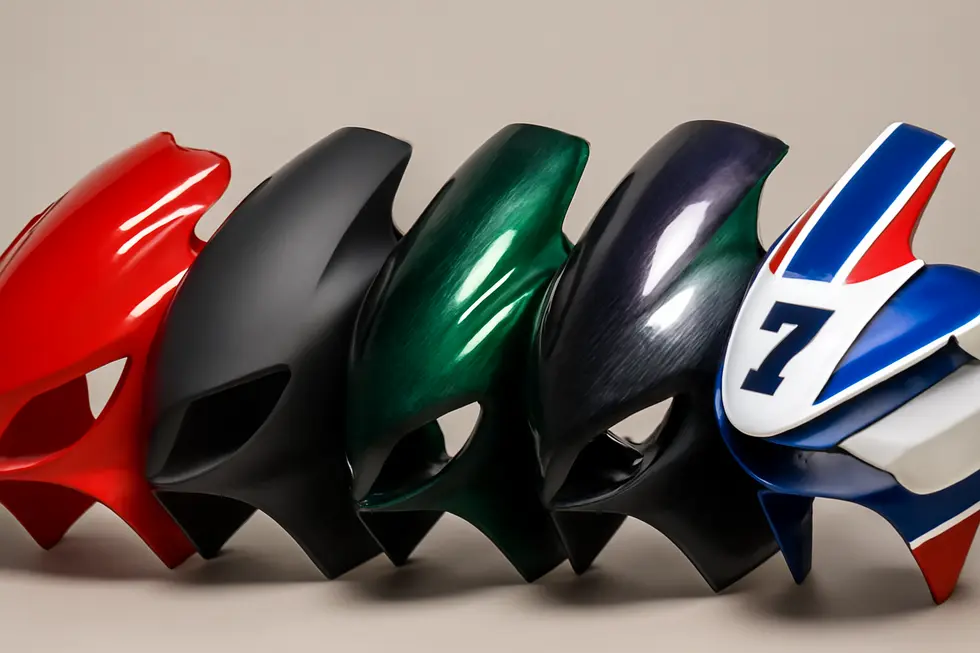
1. Diverse Finish and Design Choices Elevating Motorcycle Fairing Paint Customization
Motorcycle fairing paint designs offer a rich palette of finishes and styles that empower riders to personalize their bikes to reflect individual taste and identity. Options span from classic high-gloss finishes that deliver vibrant, reflective surfaces to matte coatings that lend a sleek, understated modernity. Enthusiasts seeking dynamic visual appeal often turn to race replica liveries, capturing the energy and style of professional motorcycles, or carbon fiber patterns that evoke advanced technology and sportiness without sacrificing weight.
Customization goes beyond base colors, incorporating graphics, decals, and multi-layer paint applications. These layered finishes enhance depth and create striking effects such as chameleon hues or subtle metallic flakes. The final appearance depends greatly on expert polishing and buffing techniques, which provide a mirror-like shine and protect the surface from fading or oxidation, ensuring long-lasting brilliance.
Many riders utilize model-specific fairing kits designed for perfect fitment and style coherence. These kits offer ready-made design foundations that can be further personalized with additional accessories or paint enhancements. This blend of varied finishes, precise craftsmanship, and tailored options allows motorcycle owners to craft uniquely expressive fairing designs that resonate with their personality and riding style.
For those looking to dive deeper into customization ideas and options, exploring the best motorcycle fairings available at Summit Fairings provides a valuable source of inspiration and quality components.
2. How Fairing Materials and Construction Quality Shape Paint Design Possibilities
The choice of materials and the quality of construction fundamental to motorcycle fairings heavily influence the aesthetic and customization potential of paint designs. Predominantly crafted from ABS plastic or fiberglass, these materials present distinct characteristics that affect both the painting process and the durability of finishes. ABS plastic offers flexibility and excellent impact resistance, lending itself well to smooth, consistent paint application and accommodating a variety of finishes from gloss to matte. Fiberglass, prized for its lightweight strength, demands meticulous preparation before custom paints or coatings can be applied, but it allows for more sculptural fairing shapes favored in high-performance motorcycles.
Beyond materials, the precision in molding and assembly plays a pivotal role in the final visual appeal. High-quality fairings ensure a flawless fit and surface, which is critical when applying multi-layered paint jobs and protective clear coats that preserve vibrancy and prevent damage. This craftsmanship enables enthusiasts to push creative boundaries with custom designs—be it metallic flakes or chameleon blends—without concerns about paint adhesion or longevity.
Additionally, material durability impacts how often and how extensively riders can modify their paintwork. ABS panels favor repeated customization thanks to their resilience, while fiberglass panels require more care but reward with unique texture options. Fairing kits designed for easy installation, complete with pre-drilled holes and hardware, further simplify the customization experience. For those seeking inspiration or options tailored to material specifics, exploring specialized sources can reveal diverse styles and practical guidance on enhancing fairing aesthetics.
3. Exploring the Boundless Creativity of Custom Motorcycle Fairing Paint Designs
Custom paint designs for motorcycle fairings unlock a vast realm of creative possibilities that reflect individual style and personality. This artistry goes beyond simple color changes, combining a rich palette of finishes—from vibrant metallics and candy coats to understated mattes and futuristic carbon fiber effects—that elevate a bike’s presence. Graphic elements such as detailed airbrush artwork, precise pinstripes, and dynamic decals enhance visual storytelling, offering riders a chance to showcase unique themes or replicate iconic race liveries. Advanced materials and surface textures influence how paint interacts with light, adding depth and performance-inspired aesthetics. Customization often extends to coordinating painted fairings with accessories like LED lighting or tail fenders, achieving harmony across the motorcycle’s design. Whether working with universal-fit fairings that adapt to various models or bespoke panels crafted for seamless integration, modern techniques ensure flawless finishes that resist wear. Riders seeking both personal expression and functional enhancement find this fusion of color, texture, and graphic artistry essential to creating a standout machine. For a deeper dive into the range of motorcycle fairing options that inspire custom designs, enthusiasts can explore comprehensive resources at Summit Fairings’ blog.
4. Mastering Finishing Techniques to Elevate Motorcycle Fairing Paint Designs
Achieving a truly standout motorcycle fairing paint design hinges not only on the paint colors and patterns but significantly on the finishing techniques applied. Polishing and buffing form the foundation of a radiant finish; using fine compounds with soft pads and precise buffer speeds imparts mirror-like gloss without damaging the fairing’s surface. This meticulous process removes imperfections and enhances depth, while a final hand-buff with microfiber cloths intensifies the shine and removes residue.
Layered paint applications add complexity and vibrancy that single coats cannot replicate. Multi-layer finishes, such as those incorporating UV-resistant clear coats or textured forged carbon fiber effects, not only enrich the visual depth but also ensure long-lasting durability against environmental stressors. Spray painting demands careful attention to preparation, primer application, and controlled spraying distances, as these steps create a smooth, even coating that supports subsequent layers and top coats.
Customization is further enhanced by integrating bespoke graphics, logos, or lace designs, which can be applied via spray or decals and sealed under clear coats to protect the artwork. Regular cleaning and detailing also play a critical role in preserving these finishes, with appropriate cleaners and gentle techniques essential to maintaining color brilliance and preventing wear. Together, these finishing techniques empower riders and custom shops alike to craft personalized, resilient, and visually enticing fairings that turn heads wherever they ride.
For those exploring options for professional-level care and detailing, the blog on Summit Fairings offers comprehensive insights into maintaining exceptional paint finishes.
5. Integrating Durability and Personalized Style in Motorcycle Fairing Paint Designs
Selecting a striking motorcycle fairing paint design involves balancing aesthetic appeal with practical considerations to ensure both beauty and longevity. Most fairings are crafted from ABS plastic, requiring specialized painting methods that promote adhesion and resilience to environmental factors, including engine heat. Using tailored primers and base coats enhances paint durability while supporting complex finishes such as metallic flakes or chameleon blends. Achieving a high-gloss or mirror-like shine demands careful polishing techniques, employing soft pads and fine compounds at controlled speeds to avoid damaging the surface. Post-polish sealing provides essential protection against UV rays, preserving vivid colors and preventing fading. Customization extends beyond paint with accessories like light pods that fit seamlessly on fairings, amplifying both style and safety without compromising design integrity. Material innovations, such as advanced polymers for side covers, boost impact resistance and weather durability, essential for parts exposed to harsh road conditions. Consistent cleaning routines and UV shielding further sustain a fresh appearance over time. Embracing these practical strategies maximizes the impact of personalized paint designs while safeguarding investment. For enthusiasts seeking detailed insights into quality fairing materials and choices, exploring dedicated motorcycle fairing resources offers comprehensive guidance to optimize both function and form.
Chapter 3: Ensuring Longevity: Maintenance and Durability in Motorcycle Fairing Paint Designs
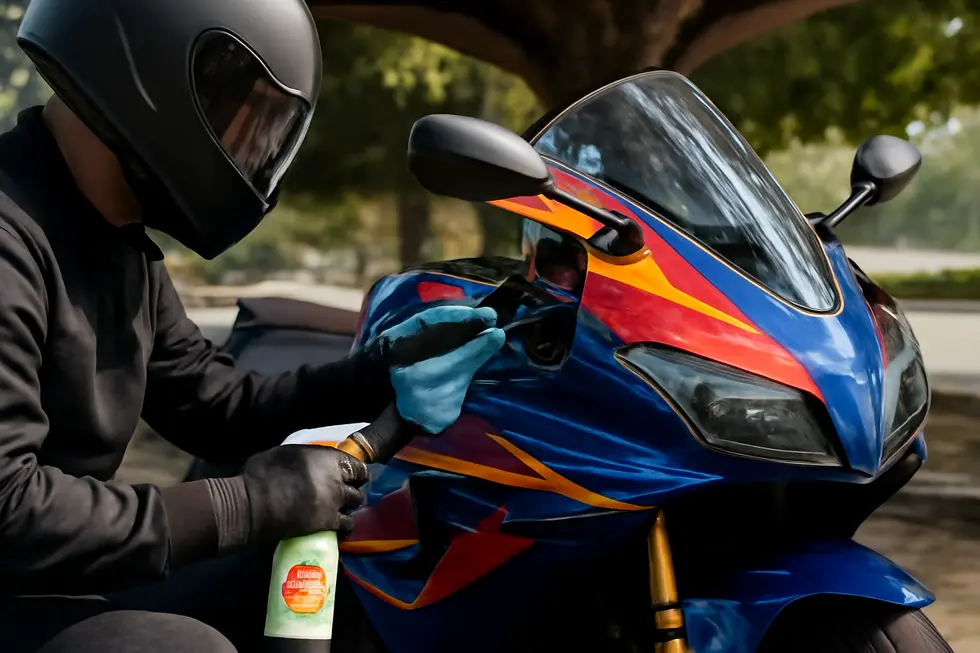
1. Essential Care for Motorcycle Fairings: Techniques for Cleaning, Protection, and Timely Inspections
Maintaining the vibrancy and durability of motorcycle fairing paint demands careful, consistent care practices. Cleaning should always start with gentle methods to safeguard both intricate paint finishes and the plastic surface beneath. Mild soap and water applied with a soft cloth effectively remove grime without risking abrasion or dulling. After washing, fairings must be thoroughly dried with a microfiber cloth to prevent water spots, which can undermine a pristine appearance. When signs of oxidation or fading arise, delicate wet sanding followed by fine polishing with plastic-specific compounds can restore clarity without damaging the design. Applying protective layers, such as waxes or ceramic coatings, seals the surface against UV rays, moisture, and environmental contaminants, preserving color depth and gloss. Routine inspections are equally vital to identify cracks, scratches, or paint chips early. Minor damage can be addressed by matching touch-up paint and blending with subtle sanding and polishing to maintain a seamless look. Custom paintwork calls for special attention through consistent cleaning and sealing to protect the artwork’s unique colors and finishes. Whether for basic or elaborate designs, following these care steps maximizes longevity and maintains the striking appeal of motorcycle fairings. For more insights on upkeep and enhancement, explore our detailed resources at your ultimate source for affordable motorcycle fairings.
2. Environmental Challenges and Protective Strategies for Lasting Motorcycle Fairing Paints
Motorcycle fairing paint designs face constant challenges from environmental factors that can significantly reduce their lifespan and visual appeal. Ultraviolet (UV) radiation from prolonged sun exposure causes paint to fade, oxidize, and chalk, especially impacting plastic fairings made from materials like ABS. Additionally, fluctuating weather conditions—including rain, salt air, and dirt accumulation—accelerate wear and corrosion on painted surfaces. Physical abrasion from harsh cleaning agents or improper washing methods further dulls the paint finish, compromising both appearance and durability.
To safeguard fairing paint, protective measures play a vital role. Parking in shaded or indoor spaces limits UV damage, while using UV-blocking covers offers added defense against sunlight and environmental debris. Applying high-quality waxes or ceramic coatings forms a resilient barrier that repels moisture, grime, and UV rays, preserving gloss and color depth. Gentle cleaning practices with mild soaps and soft cloths prevent micro-scratches that mar the surface. Consistent maintenance—through regular washing and reapplication of protective layers—is essential to sustain paint vibrancy and prevent long-term deterioration.
Beyond surface care, structural repairs like plastic welding can restore and reinforce damaged fairings, complementing paint durability by maintaining the integrity of the base material. Combining these proactive steps with premium materials and multi-layer painting processes ensures that motorcycle fairings not only capture eye-catching aesthetics but also withstand environmental rigors.
For enthusiasts seeking detailed insights and practical tips on preserving their bike’s finish, resources such as the extensive guidance found on the Summit Fairings blog offer valuable expertise to enhance longevity and maintain striking appearances.
3. Effective Repair and Restoration Techniques to Preserve Motorcycle Fairing Paints
Maintaining the visual appeal and structural integrity of motorcycle fairing paint designs hinges on precise repair and restoration methods. The foundation of any restoration starts with careful cleaning using mild soaps and soft cloths to eliminate dirt and oil residues without harming the painted plastic surface. When oxidation or fading diminishes the finish, wet sanding with progressively finer grits can restore smoothness and prepare the surface for polishing. Employing specialized plastic polishes or rubbing compounds revives clarity and shine, but aggressive mechanical methods must be avoided to prevent warping or melting.
For more significant damage like deep scratches or cracks, plastic welding offers a durable solution that surpasses traditional adhesives by seamlessly fusing broken parts. After repairs, applying protective wax or ceramic coatings seals the paintwork, enhancing resistance to UV rays and environmental wear while boosting gloss and durability. Whether refinishing a base coat or upgrading an existing design, mastering spray techniques with proper distances, layering, and drying times ensures an even, resilient coating. These combined strategies not only extend the longevity of paint designs but safeguard their intricate aesthetics.
For those seeking detailed guidance on polishing and restoring motorcycle plastics, resources such as the comprehensive walkthroughs found on the Summit Fairings blog provide valuable step-by-step insights tailored to enthusiasts and professionals alike.
4. Innovations in Application and Protective Coatings Enhancing Fairing Longevity
Advancements in motorcycle fairing paint design have transformed maintenance and durability standards through refined application methods and protective coatings. Modern fairings, primarily constructed from injection-molded ABS plastic, benefit from precise manufacturing techniques that enhance fit and surface consistency, laying the foundation for superior paint adhesion and longevity. Multi-layer painting processes, often involving up to seven stages, build robust coatings that guard against environmental hazards such as UV radiation, chemical exposure, and mechanical abrasion. These layers integrate primers, UV-stable base coats, and clear finishes that together form a resilient barrier, reducing damage from road debris and weather. Protective coatings further elevate durability; clear coats provide glossy protection while ceramic coatings introduce a hard, hydrophobic surface that resists scratches and repels contaminants. Application techniques like spraying and dipping are tailored to ensure even coverage, especially on complex fairing shapes, maximizing effectiveness. Moreover, advanced curing methods promote polymer crosslinking, enhancing hardness without compromising the plastic substrate. These innovations collectively extend a fairing’s aesthetic appeal and functional lifespan, enabling riders to enjoy vibrant, enduring finishes. For enthusiasts seeking comprehensive options and maintenance insights, exploring reliable sources focused on quality motorcycle fairings offers valuable guidance.
5. Economic and Social Benefits of Durable Paint: Enhancing Value and Rider Experience
Durability in motorcycle fairing paint designs plays a pivotal role in reducing long-term ownership costs. High-quality paints combined with protective coatings like wax or ceramic layers shield fairings from UV rays, oxidation, and environmental wear. This protection minimizes repainting and part replacement, resulting in significant cost savings over time. Routine maintenance, such as gentle washes with mild detergents, further preserves the paint finish by preventing surface degradation. These preventive investments often cost far less than repairing damaged finishes, making durability a wise economic choice.
Beyond direct financial benefits, well-maintained fairings impact insurance and resale values positively. Motorcycles with pristine paintwork typically face fewer cosmetic insurance claims and command higher resale prices, as buyers perceive a meticulously cared-for bike as more reliable. This dynamic encourages owners to balance upfront spending on premium paints or professional detailing against long-term savings and retained value.
From a societal perspective, rider satisfaction is closely tied to the aesthetic appeal of their motorcycles. A vibrant, well-kept fairing boosts owner pride and fosters community recognition, reinforcing maintenance habits through peer influence. Furthermore, durable paint systems contribute to sustainability by extending product lifespans and reducing waste from frequent repainting or replacement.
These economic and social advantages underscore why investing in durable motorcycle fairing paint is not merely cosmetic but fundamentally enhances ownership experience and value.
For those seeking quality components, explore summit fairings for premium motorcycle fairing options.
Final thoughts
Understanding motorcycle fairing paint designs is essential for business owners aiming to excel in the competitive motorcycle customization marketplace. From the intricate technological processes that guarantee professional-quality finishes, to the broad palette of aesthetic options tailored to a wide range of customer tastes, and finally to the critical maintenance and durability factors that preserve value over time, each element contributes to delivering superior product performance. By integrating these insights into operations, businesses can offer standout paint solutions that not only enhance motorcycle appearance but also ensure longevity and customer satisfaction. Embracing advanced techniques, diverse designs, and proper upkeep will position your enterprise at the forefront of the motorcycle aftermarket industry.
Ready to elevate your ride? Summit Fairings delivers premium, custom-fit fairings that blend style and durability. Whether you’re chasing speed or turning heads, we’ve got your bike covered. Don’t wait—transform your machine today. Click, customize, and ride with confidence. Your perfect fairing is just a few clicks away. Act now!
About us
undefined
RELATED POSTS
View all

